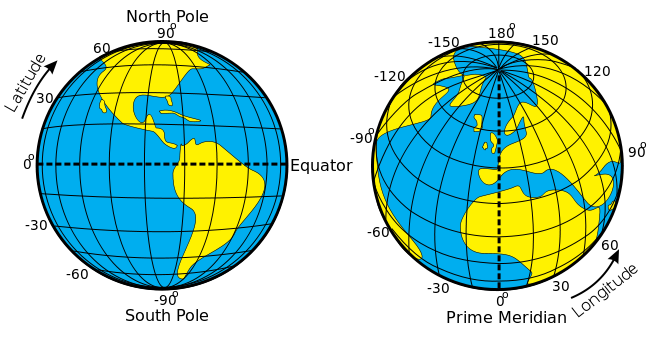The task of converting radians to degrees is reasonably trivial. However, latitudes and longitudes are usually expressed in the range -90 to 90 for longitude and -180 to 180 for latitudes.
This is only a convention – latitudes above 90 have real unique meaning, and they should not create any problems in Google Maps etc. However, when displaying latitude, longitudes as text it is best to use this convention.

Angles Greater than 360
We just need to take of 360° – for example 390° is the same as 30Â. We may also have to handle angles such as 1000°.
Latitude
Everything from 0 to 90° is as it is. However, 120° is the same as 60° and 150° is the same as 30° and 180° is the same as 0°. Anything above 180° is expressed as a negative angle i.e. 190° is -10° etc.
Coordinates 0 to -90° are as they are. However, -120° is the same as -60° and -150° is the same as -30°.
Longitude
Angles are usually expressed in the range -180° to 180°. 190° is the same as -170°, 210Â is the same as -150° until 380° which is the same as 0°.
The JavaScript Code
2
3
4
5
6
7
8
9
10
11
12
13
14
15
16
17
18
19
20
21
22
23
24
25
26
27
28
29
30
31
32
33
34
35
36
37
38
39
40
41
42
43
44
45
46
47
48
// 90 to -90
function rad2lat(rad) {
// first of all get everthing into the range -2pi to 2pi
rad = rad % (Math.PI*2);
// convert negatives to equivalent positive angle
if (rad < 0)
rad = 2*Math.PI + rad;
// restict to 0 - 180
var rad180 = rad % (Math.PI);
// anything above 90 is subtracted from 180
if (rad180 > Math.PI/2)
rad180 = Math.PI - rad180;
// if it is greater than 180 then make negative
if (rad > Math.PI)
rad = -rad180;
else
rad = rad180;
return(rad/Math.PI*180);
}
// convert radians into longitude
// 180 to -180
function rad2lng(rad) {
// first of all get everthing into the range -2pi to 2pi
rad = rad % (Math.PI*2);
if (rad < 0)
rad = 2*Math.PI + rad;
// convert negatives to equivalent positive angle
var rad360 = rad % (Math.PI*2);
// anything above 90 is subtracted from 360
if (rad360 > Math.PI)
rad360 = Math.PI*2 - rad360;
// if it is greater than 180 then make negative
if (rad > Math.PI)
rad = -rad360;
else
rad = rad360;
return(rad/Math.PI*180);
}










































































Leave a Reply